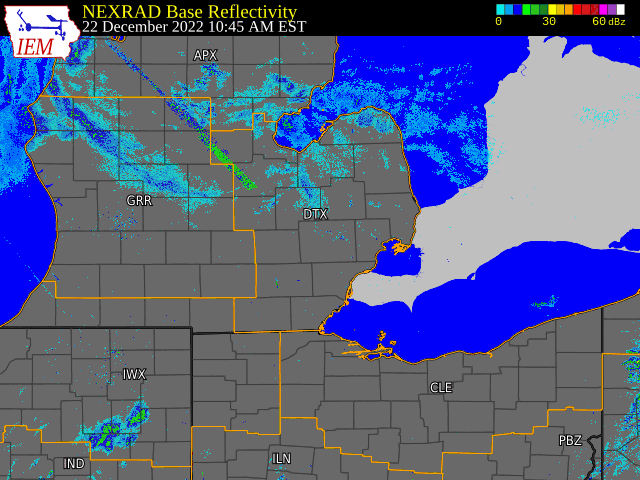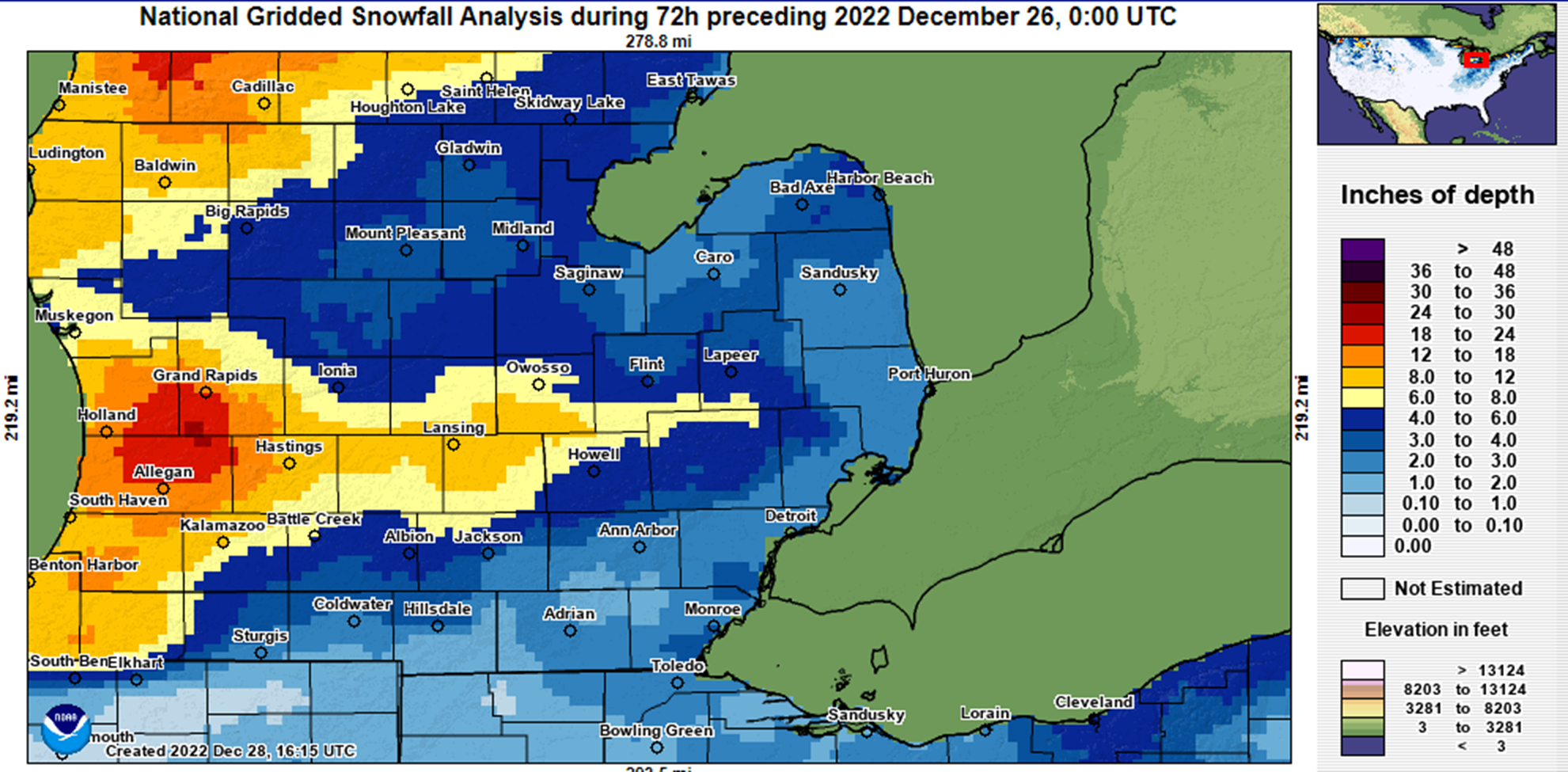Overview
Event Summary
A powerful arctic cold front surged across the Midwest eventually reaching Michigan by late day Thursday December 22nd. As this occurred, low pressure began to develop along the front over the northern Ohio Valley. This low rapidly deepened, undergoing bombogenesis, as it lifted through the central Great Lakes into southern Ontario Friday December 23rd. System slowly drifted north over the remainder of the weekend maintaining the extremely tight pressure gradient over the region resulting in a long duration of strong winds and a robust lake effect response.
The bulk of initial precipitation ahead of the arctic cold front fell as rain before rapidly transitioning to snow in the immediate wake of the frontal passage. This combined with the progressive nature of the low limited snow with the multiday scattered lake effect snow showers instead generating the bulk of snowfall amounts seen (see Snowfall tab for 3 day totals).
Rather, the primary impact of this system was the wind and cold. Temperatures rapidly fell overnight Dec 22nd into the morning of Dec 23rd with all of southeast Michigan seeing a 35-40° temperature drop resulting in a flash freeze of earlier rainfall. For example: Detroit Metro Airport went form 40°F at 11pm Dec 22 to 1°F 10am Dec 23. The still 'warm' (relatively speaking) Lake Michigan helped to blunt this airmass keeping the core of the arctic airmass to our south over the Ohio Valley. That said, temperatures remained in the single digits (both positive & negative) to positive low teens from Dec 23-25, which combined with wind gusts of 35-60mph (see Wind tab for reports), resulted in windchills ranging from the positive single digits to negative teens.
Radar
 |
|
Radar loop from 10am Thursday December 22 to 9am Sunday December 25, 2022 Arctic cold front crosses the region late Dec 22nd switching over any regions still experiencing rain to all snow with light snow continuing into the morning of Dec 23rd. Lake effect snow then ramps up over the 23rd and continues into Dec 25th. |
Wind
Public Information Statement National Weather Service Detroit/Pontiac MI 906 AM EST Sat Dec 24 2022 The following are peak wind gusts of 30 mph or more from across the region reported to the National Weather Service in White Lake over the past 24 hours (9am Dec 23 - 9am Dec 24). Port Hope 58 mph 508 PM... Saginaw Tri Cities Airport 56 mph 240 PM... Flint 54 mph 1127 AM... Pontiac 53 mph 443 PM... Ypsilanti 52 mph 137 PM... Detroit City Airport 49 mph 453 PM... Detroit Metro Airport 48 mph 603 PM... Adrian 48 mph 204 PM... Ann Arbor 47 mph 130 PM... Bad Axe 46 mph 535 PM... Saginaw Harry Browne 46 mph 715 PM... Owosso 44 mph 1215 PM... Lapeer 44 mph 1215 PM... Mount Clemens 43 mph 718 PM... Caro 41 mph 655 PM... Howell 40 mph 235 PM... Grosse Ile 40 mph 255 PM... Troy 39 mph 1055 AM... Midland 37 mph 1135 AM... Port Huron 37 mph 235 PM... Lambertville 37 mph 935 PM...
Snowfall
Public Information Statement
National Weather Service Detroit/Pontiac MI
1147 AM EST Sun Dec 25 2022
SNOW REPORTS... Covering the period from 9am Dec 22 to 9am Dec 25- this includes both snow from the low and subsequent lake effect.
NOTE: Due to the high winds throughout much of the event, variation in amounts over relatively short distances can be expected.
Location Snowfall Duration
(Inches) (Hours) Lat Lon
...Bay County...
Auburn M 5.3 72 43.60N 84.08W
...Genesee County...
4 N Goodrich M 3.9 72 42.97N 83.51W
5 SSW Flint M 6.3 72 42.97N 83.74W
...Huron County...
Bad Axe M 2.8 72 43.80N 83.00W
5 NNW Filion M 3.2 72 43.96N 83.04W
...Lapeer County...
Lapeer M 8.3 72 43.05N 83.32W
...Livingston County...
1 NE Howell M 5.9 72 42.62N 83.92W
...Oakland County...
Farmington M 2.8 72 42.46N 83.38W
4 E White Lake M 4.1 72 42.65N 83.43W
...Saginaw County...
5 S Auburn M 3.9 72 43.53N 84.08W
...Shiawassee County...
Durand M 5.5 72 42.91N 83.99W
Owosso M 8.5 72 43.00N 84.18W
...Tuscola County...
Cass City M 2.0 72 43.60N 83.18W
Vassar M 3.8 72 43.37N 83.58W
...Washtenaw County...
Ann Arbor M 5.2 72 42.28N 83.73W
...Wayne County...
Dearborn M 2.6 72 42.31N 83.21W
Garden City M 4.0 72 42.33N 83.33W
Grosse Pointe Farms M 3.2 72 42.40N 82.89W
1 SE Romulus M 4.6 72 42.21N 83.35W
Wyandotte M 4.2 72 42.21N 83.16W
M = Measured
E = Estimated
$$

 |
Media use of NWS Web News Stories is encouraged! Please acknowledge the NWS as the source of any news information accessed from this site. |
 |